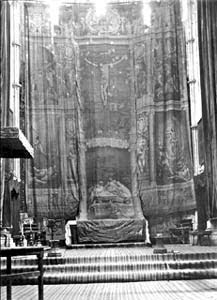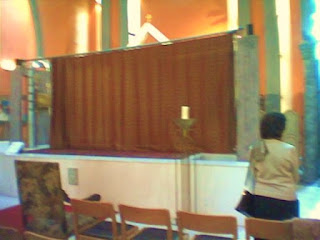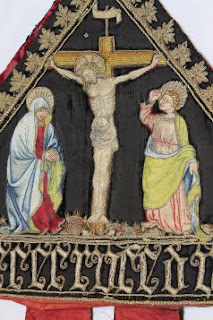Something people are generally not mindful of, these days, is the spacial divisions of churches in yesteryear.
Western Churches, especially after the reforms that began in the 1960s have become big open halls, sadly devoid of certain architectural elements which for some reason began to be thought of as divisive.
Of course they were divisive! That was what they were intended to do! Provide a visual and physical barrier between the diverse spaces of the church: to separate the area of the faithful (the nave) from the choir which was reserved for members of the clergy; and that one, from the presbytery where the altar stands.
From east to west, let us begin with the screen most people will recognized for its iconic presence (pardon the pun).
To divide the sanctuary from the choir, in most Orthodox churches, there is an Iconostasis. This is a screen decorated with painted icons of Jesus, his mother The Theotokos, of the Archangels and a plethora of Saints of particular devotion locally - hence its name. Generally, it completely shields the altar from view - except at certain points during services in which the Holy doors that pierce it, and curtains that veil it, are opened.
In the Latin West, no screens requiring doors, but the open arches that separated the sanctuary from choir, would also often have curtains to be drawn open or left closed - functioning very much as the Iconostasis in the East - to shield the altar from view at certain points during the mass which when left open provided for a greater grace, in contrast. (More on these curtains in a future post.)
Certainly, some old churches in Greece, as well as those of the Armenian Rite, maintain curtains in front of their sanctuaries to this day - whether there is an arch or not:
In the Gothispanic and later Mozarabic Rites of Spain, this curtained arch was particularly prominent in the liturgy as well. Traces of its rails can still be seen in its extant churches dotted around the Iberian peninsula previous to the official shift to the Roman Rite that started in A.D. 1050; also, in the many book illuminations of their patrimony known as Beatos.
Indeed, this practice and tradition stems back from the biblical description of the Jewish temple, where a large curtain hung in front of the Holy of Holies:
In Rome, from the time of Constantine, instead of having a linear arcade, it was common to pivot the external two arches and close off the open side with a fourth arch creating the tetrapylon, ciborium or baldachin that surround and cap many of the altars of the old basilicas.
These too would have been provided with curtains which at least in the early times, served for veiling the altar from view. This, in parallel to the other catholic rites when all were still in communion with each other.
After these curtains began to go into disuse in most of the west, the chancels retained the function of separating the altar from the choir.
Indeed, these altar rails became the place where communion was distributed, especially to the clerics placed in the choir, hence, they were often called communion rails.
They were called chancels, from the Latin term cancelas, which means a barrier, fence or frontier. For this reason, the area of the choir (and sometimes also the sanctuary) became known as the chancel in English - for it was enclosed by these low-walled divisors.
Interestingly enough, this was not just the case for religious temples. Just as the Christian church found architectural inspiration from the civic basilicas that served as courts of law in Ancient Rome, the royal halls of the various European monarchies were also provided with chancels in early times.
As an example, here is the Riksalen in Sweden, which to this day maintains the obvious divisors.
The imperial diets of the Holy Roman Empire and even the British Parliaments also maintained a disposition of seating particular to this ancient practice of dividing a basilica into different sections - even in absence of the actual barriers:
For those places where the chancels went the way of the rails (is that the saying?) The Great Officer of State who presided within its confines, in absence and name of the monarch, is aptly named the Chancellor - or Great Chancellor, Arch-Chancellor, Lord Chancellor - depending on country and time. He was the person charged with the Seal of State and thus the expedition of all the great documents of a nation in the form of Letters Patents. He is the head of the clerks, or secretaries and other learned men who in medieval times, were almost always clerics - hence their name. These clerks had their place within "the chancellery" at the royal court, like the clerics would have their place within "the chancel" of a church.
 |
| Chancellors of The United Kingdom kept the Great Seal of State in these embroidered purses... historically. |
 |
| Chacellors of France kept the Seal of State inside the box pictured here under the left hand of the Chancelier. |
But enough word association and derivatives for one day. OK, one more: we end with Merkel. :)
Which is neither here, nor there besides the obvious... but then, it is said that "merkel" is derived from the German word for frontier: mark - as in markgraf (frontier earl), Denmark (frontier of the Danes), Altmark (old frontier), etc. - which was too fortuitous not to share.
Next time, we will showcase the second divider in our journey west - the sometimes called roodscreen, which separates the choir from the nave of certain old churches of our common Catholic past.
But now... a wee refresher for those who desperately need a laugh:












































